What does tannic acid do?
What does tannic acid do?
Tannic acid, also known as tannin, gallic acid, etc., is a common component in the plant kingdom. It belongs to the class of polyphenolic compounds and is widely found in grapes, gallnuts, tea, bauhinia, cocoa, and many other plants. They are known for their molecules with polyphenolic structures, which have multiple hydroxyl and phenolic groups, giving them strong antioxidant properties. They can be divided into oxidized and condensed types. The oxidized type mainly exists in the form of anthocyanins, such as flavonoids and anthocyanin tannins, which are often pigments in plant tissues. The condensed type is a polymer formed by enzyme-catalyzed reactions of phenylpropanoid monomers, such as gallic acid.
It has an astringent taste and can react with proteins, so it is widely used in food processing and medicine. It has rich nutritional value and many health benefits, such as improving immunity, anti-oxidation, and antibacterial.

What functions does it have?
Antibacterial properties
Its antibacterial activity has long been recognized. Its principle is that it can bind to the protein and polysaccharide substances in the "capsule" formed on the surface of drug-resistant bacteria, thereby destroying the "capsule" and allowing the bactericidal substances to enter the bacteria to exert bactericidal effects, thereby achieving the purpose of killing bacteria. Of course, at high concentrations, it can also directly bind to the protein on the bacterial cell membrane, affecting the normal physiological function of bacteria, thereby inhibiting or killing bacteria.
Antioxidant and free radical scavenging
The ortho-phenolic hydroxyl contained is an excellent hydrogen donor, which has a significant scavenging effect on oxygen free radicals such as superoxide anion free radicals and hydroxyl free radicals, and can protect many biological macromolecules of the body such as proteins, DNA, and lipids from free radical attacks, thereby playing a certain protective role on body tissues.
Astringent effect
It forms a protective film with protein on the surface of the intestine, which can reduce intestinal peristalsis, slow down the movement of nutrients in the gastrointestinal tract, promote better absorption of water and nutrients, reduce water in the gastrointestinal tract, thereby controlling enteritis and reducing watery stools.
Anti-aging
It can promote cell metabolism, enhance the vitality of cells throughout the body, inhibit the activity of reactive oxygen species and free radicals, and destroy the activity of cell nucleus viruses to achieve anti-aging effects.
Inhibit the release of inflammatory factors
It can reduce the release of inflammatory factors, thereby reducing inflammatory reactions and improving the health of animals.
Improve intestinal health
It can significantly improve the growth performance and intestinal health of monogastric animals by exerting astringent, antioxidant, antibacterial and anti-inflammatory effects. For example, it can promote the rapid denaturation of epithelial cell proteins in damaged intestinal villi, increase the tight connection of epithelial cells, thereby forming a protective film that effectively prevents the exudation of body tissue fluid.
What are the main sources?
Fruits and nuts: Fruits include grapes, apples, citrus fruits and berries. Nuts include walnuts, almonds and chestnuts.
Tea and coffee: Tea and coffee beans contain more. The content in tea is considered to be an important component of tea soup, giving tea bitterness and astringency.
Beans: Beans such as soybeans and black beans, these compounds play an antioxidant and protective role in beans.
Natural plants:
It exists in the bark and fruits of many trees, such as gallnut, pomegranate, sumac, cotinus, witch hazel, oak, oak, walnut and other plants. The main purpose of these plants producing it is to resist fungal and insect invasion to protect themselves.
Effective mechanism of action to inhibit ferroptosis
Tannic acid is a condensation product of gallic acid and glucose, and is a natural polyphenol product. The polyphenol structure can be combined or complexed with polysaccharides, proteins, alkaloids, and metal ions, and can capture free radicals and have antioxidant function. Its new mechanism of action can effectively inhibit ferroptosis, laying a theoretical foundation for further development.

In the new study, the researchers used the classic ferroptosis inducer erastin to induce ferroptosis.
Cells without erastin treatment did not emit green fluorescence, but showed strong green fluorescence after erastin treatment, and this fluorescence effect could be inhibited by Fer-1; the same inhibitory effect was found in tannic acid and its parent (β-PGG)

Further fluorescence comparison studies showed that the fluorescence intensity of samples treated with β-PGG and tannic acid (50μM) was significantly lower than that of the erastin control group, and there was a significant difference between the 50μM β-PGG and 50μM tannic acid groups.

The study of live cell counts found that the percentage of live cells was Fer-1>tannic acid>β-PGG, indicating that the ability to inhibit ferroptosis was Fer-1>tannic acid>β-PGG. Studies have shown that 50μM tannic acid can completely inhibit the ferroptosis of bmMSCs, and this inhibition level is equivalent to 1μM Fer-1.

Fer-1 inhibits ferroptosis mainly by using the aromatic secondary amine N atom as an electron acceptor, hydrogen atom donor, and ferrous ion ligand. The galloyl group in tannic acid contains three adjacent phenolic hydroxyl groups, which can bind to ferrous ions to form a five-membered ring complex, which is why its inhibitory effect is stronger than that of its parent (β-PGG).

Using Fer-1 as a positive control, the ferroptosis inhibitory activity of tannic acid and its parent (β-PGG) found in cornelian beans was evaluated. The results showed that ferroptosis of bmMSCs could be inhibited through free radical capture and ferrous chelation pathways.

What can it be used for?
Daily chemical field
It can inhibit the activity of gingival hyaluronidase and collagenase. Adding it to toothpaste can prevent gum disease and periodontitis, and has anti-caries function. It has strong ultraviolet absorption characteristics, especially in the far ultraviolet region with high energy and great destructive power.
It has a strong inhibitory effect on the Maillard reaction that easily causes skin aging, so it can be used as an effective ingredient for sunscreen and anti-aging in cosmetics. Cosmetics prepared by its astringency are non-irritating to the skin, have the effect of a moderate astringent, and also have good moisturizing properties. It can also improve skin color, enhance blood circulation and promote hair growth when used in cosmetics.
Food field
It can be used as a clarifier and stabilizer for beverages and alcoholic beverages. It can also be combined with plant fibers to form solidified tannins, used as alcoholic beverage filtration adsorbents, and deironization and decolorization of soybean soy sauce. Because it contains phenolic hydroxyl groups, it has a good free radical capture function and can be used as a food antioxidant.
Medical field
Its pharmacological activity is a comprehensive reflection of its interaction with proteins, enzymes, polysaccharides, nucleic acids, etc. of organisms, as well as its antioxidant and metal ion complexing properties. Due to its certain antibacterial effect, it can protect the wound and prevent wound infection and inflammation.

If you would like more information, please contact sales@sxytorganic.com
_1737093401309.png)
